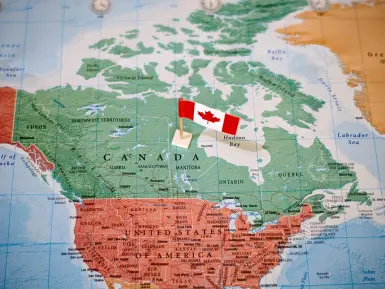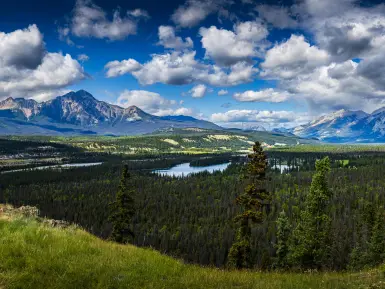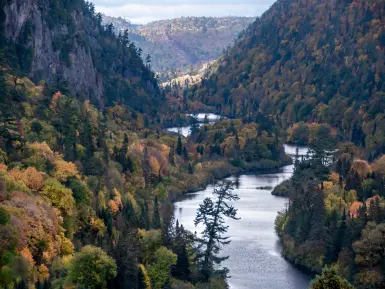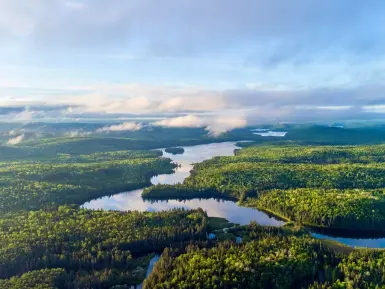Here’s one of our favourite facts for you: Canada has more lakes than all the other countries in the world combined. Canada’s lakes are integral to the country’s iconic landscape. A holiday to Canada simply wouldn’t be the same without those incredible lakes as highlights along the way.
Glaciers create those unforgettable turquoise hues that make Canada’s lakes world-famous and exquisitely picturesque. They grind rock faces down into a fine powder known as rock flour. When this powder falls into a lake, the particles hang suspended in the water and reflect the light, creating those eye-popping colours.
It’s true that where there are mountains, there are lakes, so our list of the most picturesque and popular lakes is full to the brim with locations across the country.
1. Moraine Lake, Alberta

Nestled in the Valley of the Ten Peaks, Moraine Lake in Banff National Park has to be one of the most iconic – and most photographed – lakes in the world.
This picturesque lake is found in the Valley of the Ten Peaks and is famed for amazing surroundings and its sapphire-blue water. Visit on a still day and the glassy water provides a perfect reflection of the surrounding peaks. However, Moraine Lake’s turquoise water freezes in winter and usually does not start thawing until June. If you visit the lake in the winter then there are still plenty of interesting photo opportunities for you.
Top activities to try there: As one of the most popular natural attractions in Canada, there are a lot of hiking routes to try here and opportunities to get out in a Canadian canoe.
How to get there: From the Lake Louise Village, which is located just off the Trans-Canada Highway, you need to follow Lake Louise Drive and there is an access road for Moraine Lake on the left. Follow Moraine Lake Road for around 11 kilometres to the car park.
2. Lake Ontario, Ontario

No trip to would be complete without a cruise tour to see the memorable skyline from the water. As one of the five Great Lakes, Ontario is suitably massive and spans more than 7,000 square miles.
Lake Ontario is home to some great beaches and with just over 1000km of shoreline, the deep blue lake is a water lover’s dream. The beaches at the lake are all easy to access and all vary. The urban neighbourhood beaches around Toronto are a complete contrast to the other remote, sandy beaches that can be found here. In the southwest corner of the lake, fine pebble beaches are set against the backdrop of Niagara’s vineyards and orchards.
Gabi, the programme manager for Swim Guide at Lake Ontario Waterkeeper, which is a Canadian charity, says there are a host of things to do at the lake:
“Whether you love bustling city beaches, quaint small towns, or secluded natural shores, you’ll love to swim, fish or have a drink on the shores of Lake Ontario!”
Top activities to try there: According to Lake Ontario Waterkeeper, there are tons of activities you can do in the lake itself, “The opportunities to jump into the lake are endless. There is swimming, stand-up paddleboarding, boating, kayaking, fishing, scuba diving around shipwrecks, and even surfing the winter waves.”
How to get there: If you are travelling from downtown Toronto then you will need to go on the Gardiner Expressway East to Don Valley Parkway North before merging onto Highway 401 East. Then head onto Kingston Road (ON-2 East), turn right onto Port Union Road and left onto Lawrence Avenue to get to Rouge Beach parking lot.
3. Lake Louise, Alberta

If there was any contender to Moraine Lake’s crown as the most picturesque, it would be . This enduring favourite in Banff National Park is as famous for the Fairmont Hotel as for the stunning mountain views and Victoria Glacier. Ranked by CNN as one of the most beautiful places in Canada, Lake Louise is certainly one of the most picturesque lakes in the country.
With the alpine lake’s location at the bottom of a cluster of glacier-clad peaks and its glittering turquoise waters, Lake Louise can unsurprisingly be found pictured on a lot of postcards.
We spoke to The Wandering Queen, who explained a little more about why she loves Lake Louise:
“One of my favourite lakes in Canada is the world-famous Lake Louise, located in Banff National Park. This lake is a beautiful turquoise blue lake with tall glorious mountains in the background. The views are extraordinary. Fairmont Chateau hotel is perched right next to the lake, and I loved having a meal at the hotel. The ambience was perfect with the glorious views. One of my favourite things to do at Lake Louise was to hike. I highly recommend hiking up the Lake Agnes Tea House and the Little Beehive trail.”
Lake Louise is a hugely popular Canadian ski holiday destination in winter, with three great ski resorts in the area. If you are skiing at Lake Louise, Mt Norquay or Sunshine Village then you should certainly make the effort to see the lake itself.
Top activities to try there: The lake is around 2.5 kilometres long and roughly 90-metres deep and during summer is the perfect location for visitors to go kayaking or swimming. In winter the lake turns into one of the most spectacular ice skating rinks in the country.
How to get there: To get to Lake Louise, visitors need to head towards Lake Louise Village and just like driving to Moraine Lake need to follow Lake Louise drive, but instead of turning left to Moraine drivers need to stay on the same road for a few minutes to get to Lake Louise.
4. Peyto Lake, Alberta

Peyto Lake off the Icefield Parkway is so mind-blowing that it is often unfairly accused of being photoshopped.
The lake is famed for its blue-green colour, made by the light-reflecting properties of the glacial rock flour flowing through the water. If the pictures seem unbelievable, just wait until you see the lake for yourself to discover the water’s impressive array of blue tones.
It is only 10 minutes uphill from the Icefields Parkway and is therefore very accessible for visitors.
Top activities to try there: Fishing is popular at Peyto Lake. Before heading to the lake with your fishing gear you will need to check the season, which usually runs from the end of June to October 31st and buy a national park fishing licence.
How to get there: To get access to Icefields Parkway you will need to drive on the Trans-Canada Highway 1, which is just minutes west of Lake Louise. It is around 40 kilometres to drive to Bow Summit where the Peyto Lake Lookout is located.
5. Maligne Lake, Alberta

Nestled in Jasper National Park, this lake really is a treat. At 14 miles long, a boat cruise is the best way to see the whole thing and do it justice, from the Hall of the Gods to the sacred Spirit Island.
Maligne Lake is one of Canada’s most famous lakes, known for the colour of its water, the surrounding glaciers and peaks and Spirit Island.
Just south of Jasper Town, the lake is around 14 miles long and over 300 foot deep in the south end of the lake.
The lake was commonly referred to as Beaver Lake by the First Nations and now many people head to the lake to catch a glimpse of its wildlife. Grizzly and black bears, mule deer, caribou, wolves, moose, and mountain sheep are some of the larger mammals that can be seen, while bald eagles, golden eagles and osprey are frequent visitors.
Top activities to try there: Hiking and wildlife spotting are two very popular activities to try here.
How to get there: According to Banff and Beyond, the scenic Maligne Lake drive is a must. The 46-kilometre drive starts near the town of Jasper and drivers need to take Highway 16 towards Edmonton. You will then need to turn onto Maligne Road until you reach Maligne Lake.
6. Emerald Lake, British Columbia

The largest lake in British Columbia's Yoho National Park is a stunning sight to behold. The colour of its waters lives up to its name, and the luxury Emerald Lake Lodge is its defining landmark.
Discovered back in 1882 by Tom Wilson, this lake is a sight to behold. Known for its luscious vegetation, the site is a hot spot for microclimates and wildlife alike. The shaded areas are home to species of wild orchids and fragile flower species.
We spoke to the duo at Nomadasaurus about some of the thrilling activities you can get up to at Emerald Lake: “We spent 3 years living in Canada, and were lucky enough to visit many of the country's most famous and gorgeous lakes during that time. One of our absolute favourites though is Emerald Lake in Yoho National Park, British Columbia.
“This stunning place is nestled amongst towering peaks, with plenty of rivers and waterfalls to explore in every direction. If you love being in the outdoors, Emerald Lake is a true paradise. In the summertime you can go hiking, mountain biking, climbing and kayaking, and in the winter there's plenty of opportunities for backcountry skiing, cross-country skiing, ice skating and snow-shoeing. You'll also find one of Canada's best accommodation options there, Emerald Lake Lodge. For a truly unique experience, make sure you visit Emerald Lake in winter."
Top activities to try there: Emerald lake is perfect for keen walkers, the walk around the lake can take up to an hour and offers spectacular views across the water. Wildlife spotting is also a popular past time for visitors.
How to get there: 40 minutes’ drive from Lake Louise in the centre of Yoho National Park on Highway 1. Accessible from Field on a 10-minute car ride.
7. Garibaldi Lake, British Columbia

If you’re making the trip between Vancouver and Whistler, stop off at Garibaldi Lake. It’s a turquoise gem that you don’t want to miss, complete with fantastic hiking trails.
This stunning glacier-fed lake is 1,450 metres above sea level. Nestled beside volcanic structures, alpine meadows, glaciers and snow-capped mountains, the location couldn’t be prettier.
The lake was formed when lava flows from the volcanoes of Mount Price and Clinker Peak blocked the ancestral valley, damming the waters of the lake. Now the turquoise colour of the lake – a result of rock flour being suspended in meltwater from the Sphinx and Sentinel Glaciers – attracts thousands of visitors every year.
What’s more, if you hire a car in Canada it only takes two hours to drive to the lake from Vancouver, and just 25 minutes from Whistler, which has made it an even more popular attraction.
Top activities to try there: Hiking is the number one activity to try here as there are lots of walking trails nearby to the lake such as Black Tusk and Panorama Ridge. The hike to the lake is around 18km roundtrip and takes about five to six hours. There is also the opportunity to go swimming and canoeing.
How to get there: The lake is only accessible by hiking trails and is most commonly accessed from the Rubble Creek parking lot just off the Sea To Sky Highway and is around a one and a half-hour drive from downtown Vancouver.
8. Abraham Lake, Alberta

Abraham Lake in Alberta is, in fact, an artificial lake created in 1972 with the construction of the Bighorn Dam. Now known for being Alberta’s largest reservoir, named after Silas Abraham, a resident of the lake in the 1800’s.
This lake off the North Saskatchewan River comes into its own in winter. Bubbles frozen into the ice create a magical, otherworldly scene – you wouldn’t guess they are produced by something as unglamorous as methane gas from decaying matter on the lakebed. Visitors to the site will notice the iconic smell that makes this lake as famous as it’s other Canadian counterparts.
Top activities to try there: Abraham lake is perfect for keen photographers due to its stunning bubble formations. It also makes the perfect backdrop to a Rockies walk.
How to get there: If you are flying into Calgary or Edmonton, find the David Thompson Highway (H11) which will signpost you to the lake.
9. Spotted Lake, British Columbia

Spotted Lake is situated in British Columbia’s desert and is located between Okanagan and Similkameen Valleys.
Rich in minerals like calcium, sodium and magnesium, Spotted Lake puts on a show in summer when the water in the lake evaporates. The minerals are left as concentrated spots on the surface, giving it its name Spotted Lake.
Considered a sacred location, for people in both Canada and the United States, people often believe the rock piles indicate ancient graves from former worshippers. During WW1, minerals were extracted by local harvest labourers from the lake to help make ammunition.
Top activities to try there: As the lake isn’t open for the public to walk on due to its dangerous and reserved nature, activities in the area can include nature walks in the surrounding desert and photography.
How to get there: Located in Osoyoos in Southern BC, you can drive here from Penticton in an hour.
10. Okanagan Lake, British Columbia

This is BC’s wine region. Surrounded by vineyards and boasting a Mediterranean climate, 84-mile-long Okanagan Lake is ideal for watersports, relaxing and magical sunsets. Known for its popular beaches and family-friendly play areas, the lake is a hive of activity all year round.
Known for being a location of mysterious creatures between the depths, head out on a paddleboard or adorn a snorkel and catch a glimpse of some of the wildlife that thrives in the mild climates.
Top activities to try there: Watersports are what this lake is known for, so jump in a kayak, canoe, or head out onto the water in a boat to explore the true beauty of this magnificent lake.
How to get there: From the town of Kelowna in the heart of the Okanagan Valley.
11. Lake Huron, Ontario

Originally known as La Mer Douche by French explorers, Lake Huron is the second-largest Great Lake in Canada at 23,000 square miles. Originally a vital shipping route by Native Americans, the lake is known for being home to almost 1,000 known shipwrecks from beastly storms that have hit its shores.
This huge expanse of freshwater creates an enormous coastline along Ontario’s south-eastern border. There are coves, islands and sandy beaches begging to be explored. The distinctive thumb is known for its plethora of port villages and towns.
Top activities to try there: Lake Huron is a lake full of opportunities. There are stunning walks around the area, the crystal clear waters are perfect for swimming and the expanse makes it a great location for all types of watersports.
How to get there: Bruce Peninsula National Park boasts flowerpot rock formations, a cove called the Grotto, pictured above, and a Dark Sky Preserve 3 ½ hours’ drive from Toronto.
12. Lake Superior, Ontario

The largest of the Great Lakes in Canada covering a long stretch of Ontario’s southern border with Michigan, Lake Superior lives up to its name. Towns like Agawa Bay and Thunder Bay make the most of the watersports on offer. Covering a huge 160 miles, the lake receives water from over 200 rivers and is known as the third-largest freshwater lake by volume.
Lake Superior is home to Isle Royale National Park, an archipelago of over 200 islands, easily accessible by a boat or seaplane, an adventure in itself. Wildlife is rife in the area and those visiting the lake can often spot Wolves and Moose, so keep your eyes peeled.
Top activities to try there: Such a large lake means activities come in all shapes and sizes. Water sports are very popular here with paddleboarding, swimming and canoeing being some of the most popular. Wildlife spotters also flock to the area to catch a glimpse at some of the mighty animals that roam the shores.
How to get there: Agawa Bay is a 9-hour drive from Toronto so is best enjoyed as part of a road trip or fly-drive tour. There are endless coastal coves and beaches to stop off at.
13. Bow Lake, Alberta

Bow Lake might not be one of the biggest in Banff National Park, Alberta, but it makes up for it with its stunning colours. Just 30 minutes north of Lake Louise, this icy, cold expanse sits pretty in the Canadian Rockies. The location is perfect for hiking and is popular with keen photographers.
The white hues of the snowy mountains make the waters look even bluer, a real sight for the eyes. Weather in the Rockies can be temperamental, but to see the lake in all its glory, visiting in Fall will offer you a snow-covered landscape. It is a favourite attraction on the Icefields Parkway and lies below the Crowfoot Glacier.
Top activities to try there: Hikes in the Rockies are the perfect way to see the landscapes that surround Bow Lake, offering stunning panoramic views across the waters.
How to get there: Half an hour’s drive from Lake Louise on the Icefields Parkway (Highway 93)
14. Berg Lake, British Columbia

This stunning aquamarine lake sits at the foot of Mount Robson, the highest peak in the Rockies. Not only does it afford fantastic hiking and views of the peak, but it is dotted with icebergs year-round.
The park where Berg Lake is situated is a UNESCO World Heritage site and is a must-visit destination in itself. Its unspoiled natural beauty really is a sight to see. The lake is easily accessible through a number of walking trails and visitors should expect to see lots of icebergs, even in the summer.
The lake’s turquoise-coloured water, icebergs and surrounding mountains and glaciers make for some stunning photographs.
Top activities to try there: Horseback riding, swimming, fishing and hiking are all popular pastimes for visitors to the lake.
How to get there: Visitors will need to drive to the Mount Robson Visitor Centre and then hike to Mount Berg. To get to the visitor centre from Vancouver you will need to take the Trans-Canada Highway/BC 1 East and BC-5 North to Kinney Lake Road. Continue on Kinney Lake Road and then take the Viewpoint Road, which will lead you to the visitor centre.
15. Lake Minnewanka, Alberta

Situated just 3 miles from Banff, Lake Minnewanka is another mountain edged lake with stunning blue hues. Sitting 5km wide, Minnewanka is a glacial lake perfect for hiking, mountain biking, diving and snowshoeing.
The location is known for fantastic wildlife sightings, with long deer drinking on the shoreline, bighorn sheep roaming free and woodpeckers tapping at nearby trees.
This glacial lake means “Water of the Spirits” and is a fantastic place to visit just outside of Banff. With cruises available, you can spot all sorts of wildlife along the shores of Lake Minnewanka.
Top activities to try there: Outdoor activities are great here, canoeing, kayaking, paddle boarding and diving are all popular in the clear waters. It is also a perfect place to sit and enjoy a family picnic at one of the many picnic spots.
How to get there: The 13-mile-long lake is just 3 miles from the town of Banff, meaning you can easily drive, hop on a tour bus or even walk.
It’s safe to say that Canada trumps all others when it comes to stunning and magical lakes. A holiday to Canada wouldn’t be complete without a visit to one of these stunning lakes and you would be very hard pushed to not see at least one as you explore. Search through our and start planning your next Canadian adventure.
Latest Articles

How big is Canada?


03/07/2025
A question that many people ask is ‘how big is Canada’? Most people know Canada is big, but just how big is big?

Canada Advocate Q&A: Trish & Cathie's Race Across The World Adventure


01/07/2025
Join us this Canada Day as we celebrate the breathtaking beauty of Canada with Trish & Cathie, the incredible winners of Race Across the World series 3! Discover Canada through the inspiring lens of two adventurers who truly fell in love with its majestic landscapes and vibrant culture.

Sault Ste. Marie Travel Guide: Undiscovered Canada


30/06/2025
Sault Ste. Marie in Canada is one of Ontario’s premier adventure towns, known for its rugged lakes, mountains, and world-class outdoor activities.

Algonquin Park Travel Guide: Iconic Canada


25/06/2025
Algonquin Provincial Park is one of Canada’s most spectacular wilderness regions. The park, which is Ontario’s oldest and largest provincial park, is filled with rocky ridges, fragrant maples and thousands of lakes.











